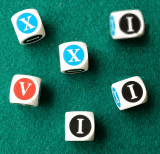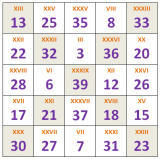These are
 four more games to play with
Alea Romana - my set of six
identical dice each bearing Roman numerals as follows: I I I V X X.
four more games to play with
Alea Romana - my set of six
identical dice each bearing Roman numerals as follows: I I I V X X.
They can all employ the following optional but recommended rule: If you roll an I before a V, the result is a number ending in 4 (IV); if after the V, then it's 6 (VI). Similarly, whether a given roll counts as (for example) 19 or 21 depends on whether the I was rolled before or after the X. As another example, if you stop after rolling (say) X, I, X, V, X, the number is 34, though if you had stopped after the first two (X, I) it would have been 11. Of course, as soon as you roll a second I only a higher number is valid. I also recommend following this rule when playing the basic game of Rouml;misch Pokern.
Centurion
Your aim is, after a series of throws, to exceed a total of 100 points by higher than anyone else.
You each in turn roll the dice, one at a time, until you either stop with a valid number or bust. If you make a valid number you add it to your score, and if it's a maximum number you get another turn. Maximum numbers are XXXIX (39, the highest possible) and those using all six dice (XXVIII 28, XXXIII 33, XXXVII 37). If you bust, you score nothing for that roll. Keep a cumulative score of all your rolls.
If you end your turn with a score of 100+ without busting, you stop play (and don't get a second turn for rolling a maximum number). When one player has reached 100+ and stopped, the others continue as before. When only one player remains, they keep going until they either reach 100+ or bust. If they bust, that ends the game. Whoever made the highest total wins.
Romanoff
Each player in turn rolls one die only, and a record is kept of the increasing total of all dice so far rolled. If you bring the total to a bust, the previous player scores the total as it stood at the end of their throw and then starts a new series of rolls.
A player may pass, in which case play continues until either someone busts the total or everyone else has passed. Whoever played last scores the total they brought it to and starts a new series of rolls. Each player keeps a running total of their scores and the winner is the first to reach any agreed target (such as 100).
Domi Domi (Lotto, Bingo)
 Each
player draws a 5x5 grid containing the numbers illustrated (left).
Each
player draws a 5x5 grid containing the numbers illustrated (left).
At each turn you roll dice one at a time until you either bust or are satisfied with the number you can make. When you make one of the valid numbers shown, cross it off or cover it up.
The winner is the first to make five in a row (or any other agreed symmetrical pattern, such as a diagonal or a quincunx).
P.S. A quincunx is the shape of the five-spot on a standard die. As for the title, when I was young Bingo was known as Lotto or Housey-Housey.
Vesuvius
Each person plays in turn. At each turn you roll dice one at a time until you either bust or choose to stop with a valid number.
It costs you 5 points to roll the first die, 4 to roll the second (total 9), 3 for the third (total 12), 2 for the fourth (= 14), 1 for the fifth (= 15), none to roll the sixth. Keep a record of how much you are "paying" for your rolls (or use 15 counters).
If you bust you score nothing, but get a minus score equivalent to the number of points you have paid.
If you stop at a valid number, you score the amount of that number, less the amount you have paid. The result may be positive, zero, or negative.
If you roll a maximum (XXVIII 28, XXXIII 33, XXXVII 37, XXXIX 39, ) you get another turn.
The winner is the player with the highest score after an agreed number of turns.
Example
1. You pay 5 and roll (say) V. You may either stop for a score of 0 (= 5 gained less 5 paid) or roll again. Suppose you roll again. Then:
2. You pay 4 and roll (say) an X. You may either stop for a score of 6 (= 15 gained less 9 paid) or roll again. Suppose you roll again. Then:
3. You pay 3 and roll (say) an I. You may either stop for a score of 4 (16 less 12) or roll again. Suppose you roll again. Then:
4. You pay 2 and roll (say) another I. You may either stop for a score of 3 (17 less 14) or roll again. Suppose you roll again. Then:
5. You pay 1 and roll (say) another X. You may either stop for a score of 12 (27 less 15) or roll again. Suppose you roll again. Then:
6. You pay nothing and roll the sixth die. If you get an X, you score 22 (37 less 15). If you get an I you score 13 (28 less 15). In either case you have made a maximum and may start again. But if you get a V you're bust: you score minus 15, and end your turn.
The above may be easier to grasp if summarised as follows in a table of pay-offs depending on when you stop rolling:
| # | pay | get | total | score |
|---|---|---|---|---|
| 1 | 5 | V | 5 | 0 |
| 2 | +4=9 | X | 15 | 6 |
| 3 | +3=12 | I | 16 | 4 |
| 4 | +2=14 | I | 17 | 3 |
| 5 | +1=15 | X | 27 | 12 |
| 6 | +0=15 | X | 37 | 22 |
| or I | 28 | 13 | ||
| or V | 0 | -15 |
Link to table of probabilities (pdf)
 |
 |
|
| Page top | Site nav |
